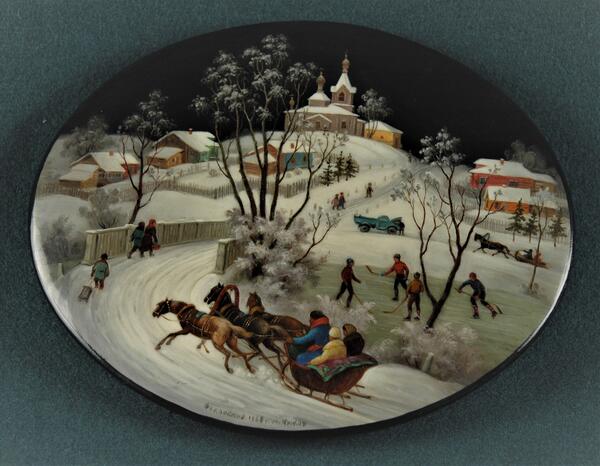The permanent exhibition “Russian Folk Art of the 17th–21st centuries” features the work of folk artisans from different regions of Russia as a unique artistic phenomenon, retrospectively shows the history of the development of Russian folk art in all its main forms of peasant handicrafts and local centers of artistic crafts. The relevance of the exhibition in the Russian Museum is undeniable: folk art is the basis of national culture.
Today, the 12 halls of the Mikhailovsky Palace house carvings and paintings on wood, ceramics, bone carvings, lacquer miniatures and decorative paintings, samples of artistic metal, lace, embroidery, weaving, and prints. Home-made objects and crafts — large and small, urban and peasant — all of them demonstrate the high professionalism of the craftsmen, the variety of materials and artistic techniques that the artisans use, as well as the poetic world of original images, themes and subjects admired by the people.
The collection of folk art in the Russian Museum is one of the largest in Russia. It includes more than 45,000 works of different types of art. It is impossible to acquaint the audience with even a part of the collections, but the permanent exhibition presents a significant amount of works that show in many ways the types and centers of folk art in their historical development.
A few examples of the 17th-century art — tiles, forged lighting fixtures, chests decorated with carved bone or iron openwork plates, shawls with fine silk embroidery or a huge embroidered tablecloth — are a unique part of the collection. The products of many art centers of the 18th–20th centuries (Kholmogory bone carving, Gzhel majolica, faience and porcelain, niello objects and others), which remained active for several centuries, show the development of artistic tastes and a change in art styles. On the contrary, the products of peasant women — weavers and embroiderers — testify to the careful preservation of ancient traditions associated with the ideas of their Slavic ancestors. Large crafts — Dymkovo or Bogorodskoye toys, focused on the interests of urban residents, or Vologda lace, popular around the world — are shown in the exposition next to the peasant craft of cube woodblock printing on textiles or painting household wooden products: distaffs, ladles, spoons and cylinder birch-bark boxes.
The 20th-century folk art includes traditional works of village craftsmen and established centers of art crafts, unique works of leading craftsmen and artists. Khokhloma, Gorodets, Polkhov-Maidan painting, Shemogod openwork birch bark, lacquer painting and strict graphics of northern niello techniques, embroidered and lace panels and tablecloths show the rich art world of the Soviet era with its construction sites, working days and holidays, friendship of peoples; history and culture of the country.
Exhibits are marked with AR stickers for identification purposes.
Today, the 12 halls of the Mikhailovsky Palace house carvings and paintings on wood, ceramics, bone carvings, lacquer miniatures and decorative paintings, samples of artistic metal, lace, embroidery, weaving, and prints. Home-made objects and crafts — large and small, urban and peasant — all of them demonstrate the high professionalism of the craftsmen, the variety of materials and artistic techniques that the artisans use, as well as the poetic world of original images, themes and subjects admired by the people.
The collection of folk art in the Russian Museum is one of the largest in Russia. It includes more than 45,000 works of different types of art. It is impossible to acquaint the audience with even a part of the collections, but the permanent exhibition presents a significant amount of works that show in many ways the types and centers of folk art in their historical development.
A few examples of the 17th-century art — tiles, forged lighting fixtures, chests decorated with carved bone or iron openwork plates, shawls with fine silk embroidery or a huge embroidered tablecloth — are a unique part of the collection. The products of many art centers of the 18th–20th centuries (Kholmogory bone carving, Gzhel majolica, faience and porcelain, niello objects and others), which remained active for several centuries, show the development of artistic tastes and a change in art styles. On the contrary, the products of peasant women — weavers and embroiderers — testify to the careful preservation of ancient traditions associated with the ideas of their Slavic ancestors. Large crafts — Dymkovo or Bogorodskoye toys, focused on the interests of urban residents, or Vologda lace, popular around the world — are shown in the exposition next to the peasant craft of cube woodblock printing on textiles or painting household wooden products: distaffs, ladles, spoons and cylinder birch-bark boxes.
The 20th-century folk art includes traditional works of village craftsmen and established centers of art crafts, unique works of leading craftsmen and artists. Khokhloma, Gorodets, Polkhov-Maidan painting, Shemogod openwork birch bark, lacquer painting and strict graphics of northern niello techniques, embroidered and lace panels and tablecloths show the rich art world of the Soviet era with its construction sites, working days and holidays, friendship of peoples; history and culture of the country.
Exhibits are marked with AR stickers for identification purposes.

